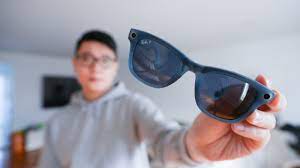
ADVERTISEMENT
How to Spot Fake Ray-Bans: A Comprehensive Guide
Introduction
In the world of fashion accessories, Ray-Ban sunglasses stand out as a symbol of style and sophistication. However, the popularity of this iconic brand has attracted counterfeiters aiming to capitalize on its reputation. In this guide, we’ll explore practical methods to distinguish genuine Ray-Bans from fraudulent copies, ensuring you make a smart and informed purchase.
1. Looking for Manufacturing Flaws

1.1 Frames

Genuine Ray-Bans boast frames cut from single pieces of high-quality acetate. Check for nicks, rough spots, or seams, as these are telltale signs of cheap imitations.
1.2 Weight
Authentic Ray-Bans have a solid and substantial feel. If the glasses seem unusually light, thin, or fragile, they may be counterfeit.
1.3 Lenses

Examine the lenses for the look, feel, and sound of genuine glass. Glass lenses are a strong indicator of authenticity, but high-quality plastic lenses may also be legitimate.
1.4 Hinges

Inspect the hinges for metal construction and smooth operation. Genuine Ray-Bans often feature a distinctive metal hinge with interlocking teeth.
1.5 Brand Etching

Authentic Ray-Bans have a small “RB” etched on the left lens. Poorly detailed or sticker-like etching suggests fake glasses.
1.6 Nose Pads

Check the nose pads for high-quality rubber material. Newer glasses should have an “RB” engraving on the metal piece inside.
1.7 Logo

Ensure the cursive “Ray-Ban” logo on the glasses’ arm is cleanly embedded. Cheap or uneven printing may indicate a knock-off.
1.8 Serial Number

Verify the serial number inside the arms. Authentic Ray-Bans may say “Made in China” but still be genuine.
2. Analyzing the Packaging
2.1 Box Serial Numbers

Check the box for a white shipping label with model and submodel numbers, lens type code, and lens width. Missing or incorrect information raises suspicion.
2.2 Carrying Case

Authentic Ray-Bans come with a carrying case featuring a sharp gold logo, Ray-Ban logo on the snap, textured material, and clean stitching.
2.3 Printing Errors in Booklet

Examine the included booklet for flawless printing on matte paper. Any errors in spelling, grammar, or print quality suggest fake glasses.
2.4 Cleaning Cloth

Ensure the cleaning cloth has the Ray-Ban logo and lacks stains, signs of use, or cheap-looking material.
2.5 Lens Sticker

Check for a black and gold cling-on sticker with the Ray-Ban logo. Missing text, off-center logo, or glue under the sticker could indicate a counterfeit.
3. Choosing Reputable Sources

3.1 Ray-Ban’s Official Website

To guarantee authenticity, purchase Ray-Bans directly from their official website, where you can browse the entire catalog.
3.2 Licensed Retailers
Buy from officially-licensed retailers to avoid shady sellers. Ray-Ban’s online search tool can help you find verified sellers.
3.3 Sellers with High Price Points
Be wary of prices that seem too good to be true. Genuine Ray-Bans are premium goods sold at premium prices.
ADVERTISEMENT
Conclusion
In a market flooded with counterfeit products, spotting fake Ray-Bans requires a keen eye for detail. By following the steps outlined in this guide, you can confidently differentiate between genuine and fake sunglasses, ensuring you invest in the quality and style synonymous with the Ray-Ban brand.
Leave a Reply